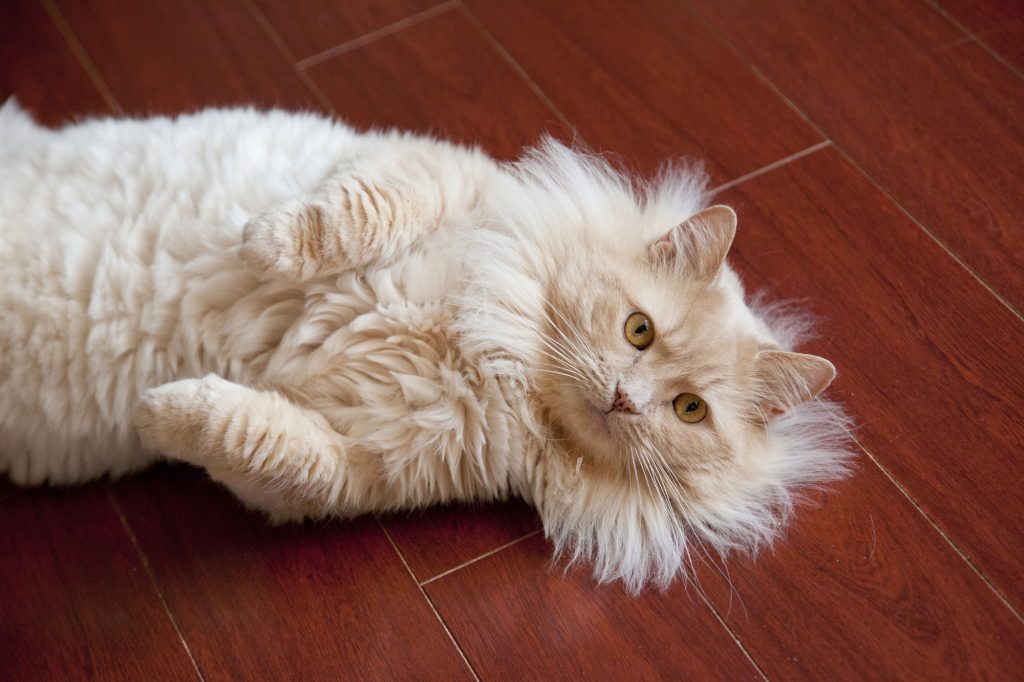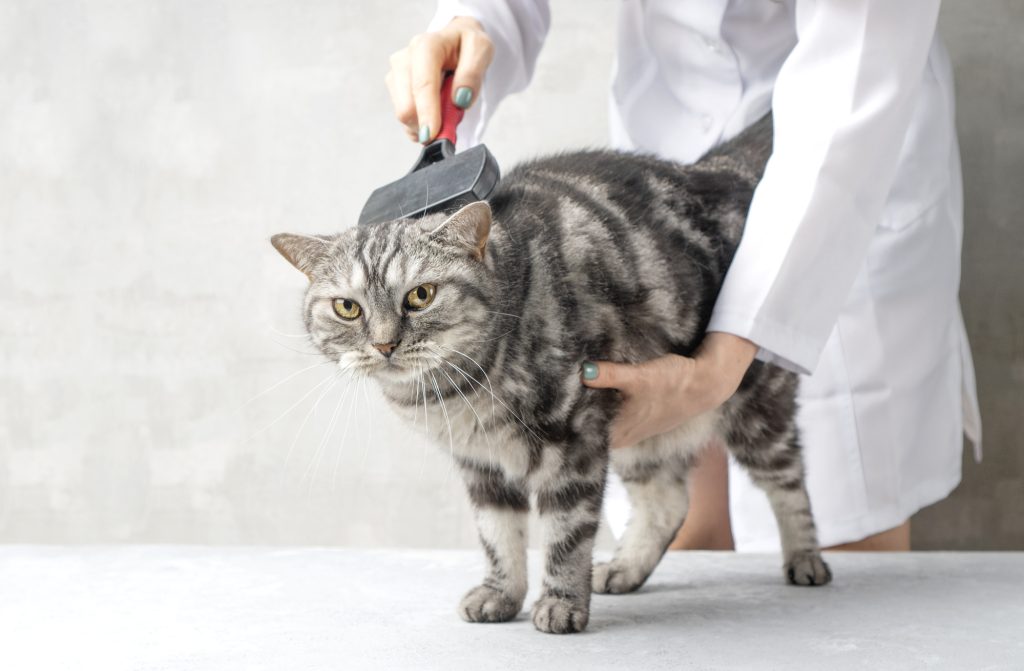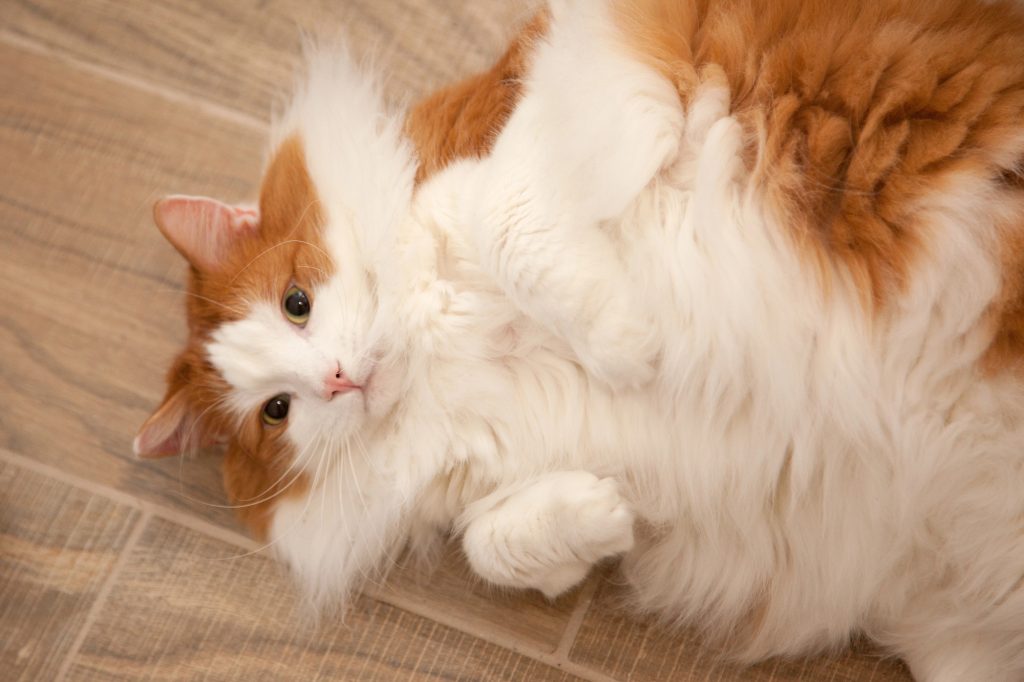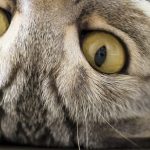Table of Contents
When long-haired cats shed their undercoat, the loose hair can intertwine with the topcoat, forming matted cat fur that is tough to manage. For pet parents who want to remove matted cat hair without resorting to cutting, it requires patience, the right tools, and a gentle touch. The backward-facing barbs on a cat’s tongue are designed to aid grooming, but sometimes they aren’t enough to prevent mats, especially if the cat lacks the flexibility to properly groom themselves or the mats are in hard-to-reach areas.
Matted hair isn’t just unsightly; it’s also uncomfortable for your feline friend, affecting the skin underneath. To maintain your cat’s well-being and appearance, routine care is essential. This guide will walk you through the process of detangling your cat’s coat, ensuring both you and your kitty have a stress-free grooming experience.
What Is Matted Cat Hair?
Matted cat fur consists of clumps of hair that have knotted tightly against the skin. It’s more common in long-haired cats but can occur in any breed. When a cat sheds their undercoat, if not properly brushed away, the loose fur can get caught in the backward-facing barbs of their tongue. These barbs also promote self-grooming, but sometimes, they contribute to the formation of mats. Without the ability to remove matted cat hair, the entanglements can lead to discomfort and health issues by pulling on the skin and affecting the skin’s health.

Causes of Matted Fur
Matted cat fur can arise from several factors, including skin issues which make a cat more susceptible to matting.
• Lack of Regular Brushing and Grooming
Regular brushing is essential in preventing matted hair, as it helps remove loose fur before it can form into knots. Cats with long fur or who are less flexible and cannot groom themselves effectively are especially reliant on their pet parents for help with maintaining their coat’s smoothness.
• Coat Types
Cats with dense or long fur are more prone to developing matted hair, as their thick coats trap more loose hair. Certain breeds require more frequent grooming sessions to keep their fur mat-free and healthy.
• Health Conditions
If a cat is ill or overweight, they may lose the flexibility to properly groom themselves, leading to neglected areas of their coat which can quickly become matted. Arthritis and other mobility issues also contribute to this problem.
Risks of Leaving Matted Fur Untreated
If matted cat fur is left untreated, it can compromise a cat’s health. While cats groom themselves naturally, some areas may require human intervention to prevent severe matting.
• Skin Irritation
Matted fur pulls on the skin and traps moisture, leading to irritation and possible skin infections. Regular grooming helps prevent these painful mats from forming and keeps the skin healthy.
• Decreased Mobility and Comfort for the Cat
Matted cat fur can restrict a cat’s movement and cause discomfort. Over time, severe matting can even affect a cat’s posture and walking patterns, highlighting the importance of keeping their fur detangled.
• Potential for Mats to Worsen and Become Impossible to Remove
Without timely attention, matted fur can become so tight and close to the skin that it’s almost impossible to remove without cutting, which could potentially harm the cat’s skin.
Preparing to Detangle Matted Fur
Before attempting to work on matted areas, it’s crucial to prepare properly to avoid harming the cat’s skin. A fine-toothed comb, cornstarch or talcum powder, and a detangling spray can be helpful during a prolonged brushing session.
Gather the Right Tools
Having the right tools is critical for a successful grooming session. A fine-toothed comb and a metal comb are essential for working through smaller tangles and mats. Cornstarch or talcum powder can help loosen mats, while detangling spray can make the process smoother for short-haired cats. It’s important to gently brush around the mat with your fingers first to assess its size and density before using the tools. Cat owners should always ensure they have a relaxed cat before starting to groom.
Set up a Comfortable Grooming Area
Creating a comfortable grooming area is crucial for a stress-free experience for both the cat and the owner. Having cat treats on hand can help keep the cat calm and reward them for their patience during the grooming process.

The Art of Detangling: Techniques for a Smooth Coat
Detangling matted cat fur is an art that requires a gentle approach and the right technique to avoid discomfort.
Starting With Gentle Brush Strokes
Gentle brush strokes can help to gradually loosen the fur. In some cases, a bit of olive oil can be used to soften the mats, making it easier to work through them without causing pain to your cat.
Working on the Mats: Patience and Care
When you encounter a mat in your cat’s fur, it’s essential to approach the task with patience. Quick fixes can lead to pain and discomfort for your beloved pet and potentially cause health issues for your cat. Instead, take the time to work through cases of matting with care, treating each mat as a minor nuisance rather than a crisis.
Gently Loosen the Mat With Your Fingers
Start by using your fingers to gently tease apart the fibers of the mat. Be mindful of your cat’s skin underneath, as it can be very sensitive. Careful manipulation can loosen the mats without causing your cat undue stress or discomfort. In some instances, mats grow too tight and might require professional care to avoid anesthesia and shaved patches.
Apply a Detangling Product and Let It Soak In
Detangling sprays or conditioners can be a great help in addressing matted fur. Apply a pet-safe product directly onto the problem area and allow it to soak in, softening the mat. This step not only eases the detangling process but also helps to minimize the risk of irritating your cat’s skin or exacerbating any underlying health issues.
Carefully Work Through the Mat With a Dematting Tool
After the detangling product has had time to work, use a dematting tool designed for cats to gently separate the tangled hair. Start from the outer edge of the mat and work inwards, taking care not to pull too hard. Remember, the aim is to preserve as much fur as possible while eliminating the mat.
Avoid Pulling or Tugging on the Mat
It’s crucial not to pull or tug on the mat as this can cause significant pain and distress to your cat. If the mat does not yield to gentle brushing and detangling, seek professional help. Pulling on the mat can damage your cat’s skin and lead to more severe health issues.
Maintenance to Prevent Future Matting
Preventing mats before they begin is key. Establish a regular grooming routine, especially for older cats, longhaired cats, and overweight cats, as they are more prone to developing mats due to their grooming habits and cat’s body shape.
Regular Grooming and Brushing Schedule
Implementing a consistent grooming schedule is one of the best ways to prevent mats. Brush your cat several times a week, or daily for those with longer fur. Not only does this keep their coat smooth, but it also provides an opportunity to check for any early signs of matting or health concerns.
Incorporating a Healthy Diet for Coat Health
A nutritious diet enriched with vitamin E and omega 3 fatty acids can contribute significantly to a healthy coat. These nutrients support the cat’s skin and fur, promoting natural oils that keep the coat sleek and less likely to mat. Always ensure your cat has access to fresh water to stay hydrated and support skin health.
Seeking Professional Grooming Assistance
If your cat is particularly prone to matting, or if you’re unsure about how to handle a mat, professional groomers can provide valuable assistance. They have the experience and tools necessary to safely remove mats without causing harm to your cat.
Moreover, a professional groomer can offer advice on maintaining your cat’s coat based on their individual needs and grooming habits, helping to prevent future issues with matting.
Post-Grooming: Ensuring Your Cat’s Comfort
After grooming, it’s important to make your cat feel safe and comfortable. The process might have been stressful, so offering a quiet place to rest can help them recover.
Rewards and Positive Reinforcement
Grooming can be a stressful experience for cats, so it’s important to associate it with positive outcomes. Offering treats, affection, or playtime after grooming sessions can help your cat develop a more favorable view of the process. Positive reinforcement encourages good grooming habits and can make future sessions easier for both of you.
Remember to praise your cat throughout the grooming process as well. A calm voice and gentle touch go a long way in reassuring your pet that they are safe and loved, even when they might be feeling anxious or uncomfortable.
Monitoring Skin Health After Mat Removal
After removing mats, keep an eye on your cat’s skin for any signs of irritation or injury. Mats can sometimes hide skin conditions that need attention. If you notice redness, swelling, or continued discomfort, it may be best to consult your veterinarian.
Regular brushing can help you monitor your cat’s skin health while also preventing future cases of matting. It’s a simple way to ensure your pet stays happy, healthy, and comfortable.

Frequently Asked Questions
1. Are there any home remedies or products that can help prevent matting?
Yes, brushing your cat regularly with the appropriate tools is the best home remedy for preventing mats. For older cats, longhaired cats, or overweight cats, who may struggle to groom themselves effectively, regular brushing is especially important. Some pet parents also use detangling sprays to help keep their cat’s fur smooth.
2. How can I make the dematting process more comfortable for my cat?
To make dematting more comfortable, establish calm grooming habits early on. Begin with short sessions and gradually increase the duration. Always be gentle to avoid pain and discomfort, and stop if your cat shows signs of stress. Addressing minor nuisances early on can prevent mats from growing to a size that may require anesthesia and shaved areas, which could also reveal underlying health issues.
3. Can I use regular scissors to cut out matted fur?
Using regular scissors to cut out matted fur is not recommended, as they can easily harm the skin beneath a cat’s mats. Cats are fantastic self-groomers, but sometimes areas like the armpits or the base of the tail can develop mats, especially in senior cats. Instead of scissors, opt for safety-tipped shears if cutting becomes necessary and always proceed with caution to prevent injuries.
Wrapping Up the Feline Detangling Journey
As we conclude the process of detangling our feline friends, it’s essential to reflect on the importance of maintenance. Getting rid of the entwined and matted fur on a cat’s body is more than just a cosmetic concern—it’s about their well-being. By ensuring that fur becomes knotted and entangled less often, we promote the overall health and happiness of our beloved pets. Remember, some cat breeds may require more frequent attention due to their unique coat types, so staying informed about your cat’s needs is key.

Hi, I’m Zoey, a devoted mom to two charming Siamese cats. My passion lies in assisting fellow pet owners in providing optimal care for their cats. On CatsEuphoria, I share practical tips and relatable stories, inviting you to join me in appreciating the authentic bond between humans and our beloved feline companions.




